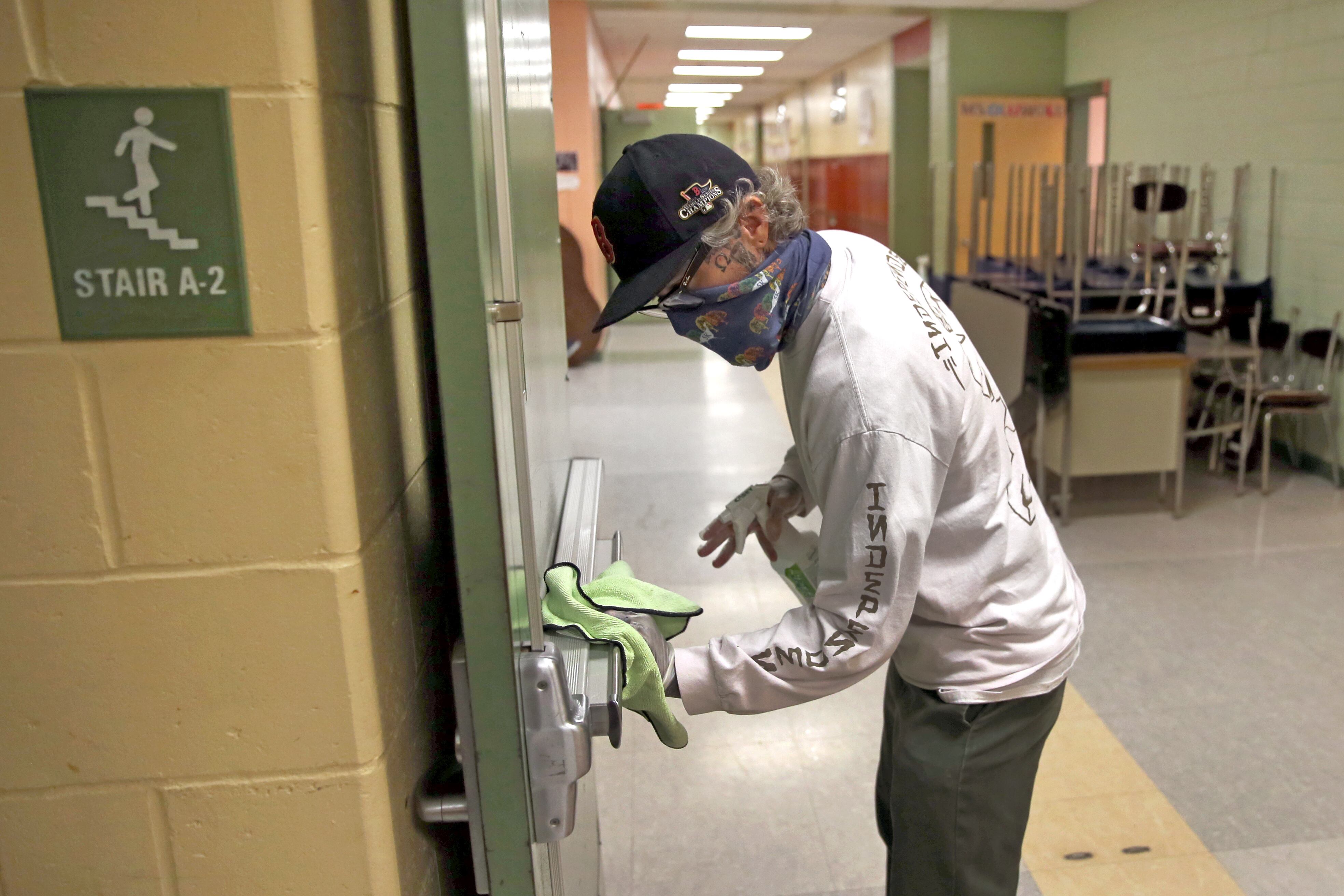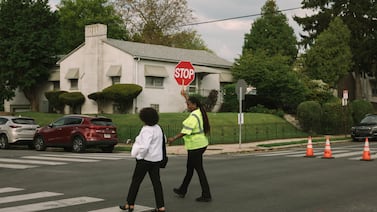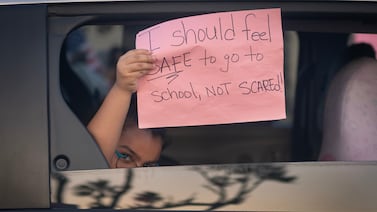For Guy Robinson, this spring’s remote learning experiment wasn’t easy.
He helps care for his grandsons, who are entering third and sixth grade in Oakland’s public schools. “Whatever they pay those teachers, it ain’t enough,” he said. “Me trying to teach them — no way.”
So one might think that Robinson would be pushing his local schools to reopen in-person this fall. But he supports Oakland Unified’s recent decision to start the school year virtually.
“I don’t hope the buildings would open at all right now, because the virus is still there,” he said. “We would absolutely be putting the children at risk.”
State and national polls show that many parents and caregivers share Robinson’s misgivings, despite the difficulty remote learning has posed for many families and children’s lower risk of getting seriously ill from COVID-19. That was clear even in polls conducted before the recent national spike in virus cases, which may have boosted parent skepticism. Parents’ views could help explain why more districts are making the choice to start the school year remotely, and portend many students staying home even if their schools do reopen.
Black and Hispanic parents appear particularly concerned about the idea of reopening school buildings, which may reflect the way the coronavirus has disproportionately affected those groups.
In one recent California poll, just 17% of parents of color and 30% of white parents believed that students should attend in-person classes daily this fall. California parents were about evenly split between wanting schools to partially reopen and remaining fully virtual until the virus is under control. California’s two largest districts announced this week that they plan to start the coming school year virtually.
Most of the polls were conducted before the Trump administration began pressuring schools to reopen. That adds a note of uncertainty, as it’s unclear how persuaded parents will be by the administration’s case.
But one new national survey, conducted in recent days, found that nearly three-quarters of parents felt there was a large to moderate risk of sending students back to school this fall. For Black and Hispanic parents, the numbers were even higher.
“I know the argument that kids don’t get sick, but there’s so many people that live in different situations, with older relatives,” said Janine Harper, a Brooklyn parent of a rising sixth grader. “I’m very concerned.” New York City’s public schools plan to offer in-person instruction one to three days a week for most students, but right now, Harper expects to keep her daughter home learning remotely.
National polls show that many parents are wary of reopening in person
One national survey of parents, released by the National Parents Union, framed the issue bluntly: Should schools “remain closed until they are certain there is no health risk,” or “reopen as soon as possible so students don’t fall too far behind”?
In several waves of polls, starting in early May and running through mid-June, most parents said schools should err on the side of remaining closed. Still, the share of parents who supported reopening edged up to 36% by June, perhaps reflecting flattening infection rates. (More recent numbers, which might reflect the recent spike in viruses, are not available.)
Another poll, released by EdChoice, asked parents in mid-June whether they were comfortable with their child returning to school in the fall. Only 26% said they were, and another 31% said they were somewhat comfortable. A total of 40% said they were not that comfortable or not at all comfortable. (EdChoice is a funder of Chalkbeat.)
Not surprisingly, the same poll found that more than a third of parents said they were very likely to opt into virtual learning if given the choice. Another third said they were somewhat likely to take up that option. In other words, two-thirds of parents were at least considering avoiding school buildings altogether.
Similarly, another mid-June poll by Politico found that a majority of parents were uncomfortable reopening schools in the fall, although a substantial minority — 42% — said they were at least somewhat comfortable doing so.
Harper says her plan to keep her daughter home is influenced by a number of factors: uncertainty about the health risks for children, including her daughter who has asthma; skepticism that schools can successfully implement health guidelines; and concerns about spreading the disease to others, including teachers.
“If anything were to happen to them because of this situation — I just don’t feel like that’s also being taken into consideration,” she said.
Robinson was also skeptical that some of the proposed health measures could work for young children. “I know my two grandsons,” he added. “I can just imagine them having to wear a mask all day … and I just don’t see it.”
Some parents are hunkering down for the long haul. “It’s just not worth the risk to me. I’d rather live a sheltered life for a year or two if I have to and give them 20 more years,” Laura Stoner said of her two twins who have underlying health conditions at home in San Marcos, California, where the district that has yet to decide on how schools will be open in the fall. Either way, her twins will stay home.
A Gallup poll from late May and early June found the most favorable perspectives on returning to school buildings. Fifty-six percent of parents said they wanted to return to full-time in-person instruction, while 37% preferred a hybrid approach. Only 7% chose full-time distance learning.
The relative enthusiasm for in-person instruction might reflect the framing of the question, which simply asked parents what they wanted this fall without mentioning health concerns, as some other polls have.
Katie Isberner is one of those parents who want in-person instruction to start as soon as possible. These days, she works full-time out of her San Diego home while caring for a 6-year-old and a 4-year-old, and she is eager to get her kids back to their routine.
“I feel like my kids are losing the expectation of what I expect for them as little humans in society because we don’t go to school anymore,” she said.
Some polls show that parents of color are most skeptical of returning to school buildings
How safe do parents feel sending their children back to school buildings this fall? Race seems to be a factor. In the National Parents Union poll conducted in June, 34% of white parents said they expected to feel safe sending their children back at the beginning of the school year, compared to just 19% of parents of color.
This aligns with statewide polls in California and Massachusetts, and a school district poll in Palm Beach County, Florida. The Massachusetts survey found that 69% of white parents in the state were confident that their local schools could stop the spread of the virus if they reopened. Only 48% of Black and 44% of Latino parents were similarly confident.
In Palm Beach, one of the country’s largest school districts, 19% of white families who responded said they would not send their kids back to full time classes in August; 29% of Hispanic families and 37% of Black families said they wouldn’t send their children back.
The racial disparities are likely due to a number of factors: higher rates of infection and death from COVID-19 among people of color, distrust of institutions that have not historically prioritized their safety, and the politics of reopening, in which Democrats have expressed more skepticism.
“Our kids have been devalued so long,” said Harper, who is Black. “It’s just really difficult to trust that people are going to fight on your behalf.”
These racial differences also have some troubling implications for the accuracy of many school district surveys of families’ preferences for the fall. Black and Hispanic families have been underrepresented in the responses to surveys in some places, while white families have been overrepresented, an imbalance that could paint a skewed picture of parents’ desire for schools to reopen.
For instance, Black and Hispanic students represent 64% of Palm Beach County’s student body, but only 42% of the families who responded to the district’s survey.






